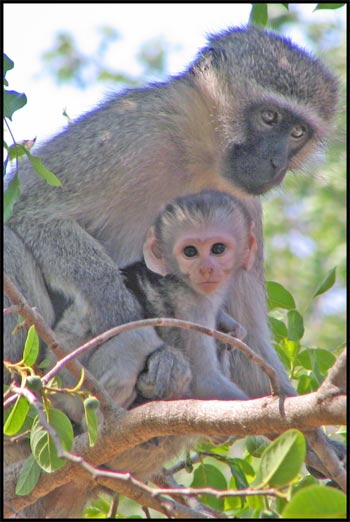
It's a delight to take a picture of baby monkey – they are so full of energy that they almost always provide action shots or at least pictures with a high “cute” factor.
After a gestation period of 6 months, a single infant is born. Its pink ears look too large for its head during its first months.
Baboons have different personalities and where some babies cling to their mothers, others are inquisitive and active.
I sat watching a troop of Chacma baboons by the riverside in the Kruger National Park of South Africa recently and there was a very small one that kept jumping on the backs of older baboons, then clumsily tried to scale a large rock...it literally couldn’t sit still for more than 3 seconds.

A baby baboon clings to its mothers’ tummy when the troop’s on the move. When they’re a little bigger, they ride on her back, like in the picture of baby monkey above. Baboons spend most of their time on the ground.
They stay under their mother’s protection for about a year. During that time they form bonds among other baboons of the same age through play – fun to watch on safari and a great opportunity to take baby monkey pictures.
Baby Vervet Monkey
Vervet monkeys also give birth to a single infant, with a slightly longer gestation period of 7 months.
As can be seen on some pictures of baby monkeys, mother Vervet monkeys protect their young by carrying them around with her as she moves around in trees, eating. She remains agile even though she carries this extra weight around with her.
These monkeys spend a lot of time grooming each other... I have often stumbled upon mothers searching their baby’s fur for ticks. The physical contact is important to instil security in the young.
Once they start finding their own feet, baby monkeys play with each other and hop around in the treetops much to their own enjoyment and those of us lucky enough to be watching them, offering many opportunities to take a picture of baby monkey.

